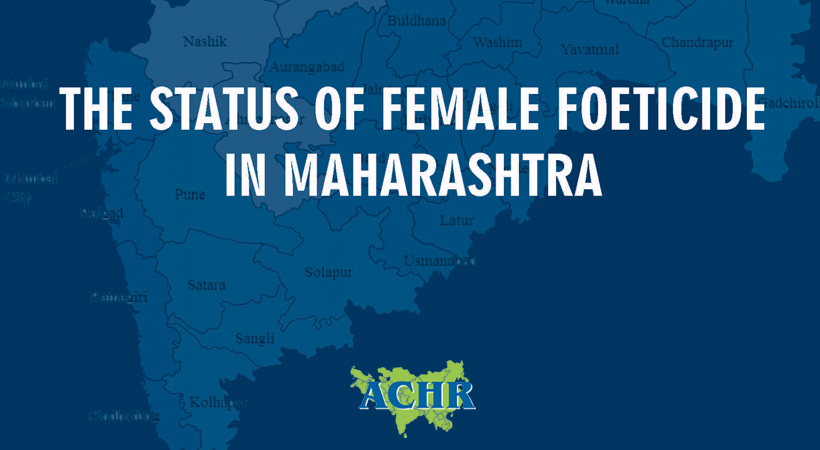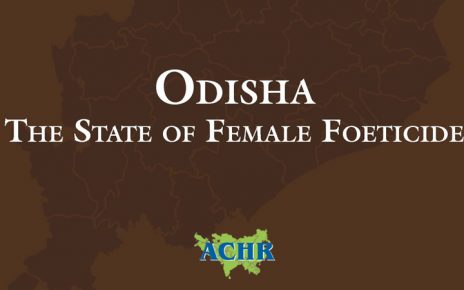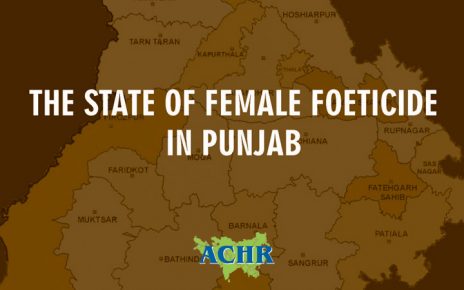Maharashtra has been at the forefront of the leading initiatives against female foeticide. It was the first State in India to enact a law to protect the female foetus by enacting the Maharashtra Regulation of Use of PreNatal Diagnostic Techniques Act in 1987, much before the enactment of the Prevention of Misuse of Pre-Natal Diagnostic Techniques Act (PNDT) in 1994 by Government of India. The Government of Maharashtra has taken a number of measures to address falling CSR by seeking better implementation of the Pre-Conception and Pre-natal Diagnostic Techniques (Regulation and Prevention of Misuse) Act, 1994 (PC&PNDT Act) and launching specific schemes for retention of girl child.
That Maharashtra recorded 9th lowest Child Sex Ratio (CSR) among 35 States and UTs of India with CSR of 894 against national CSR average of 919 speaks its failure. An estimated 6,82,081 girls altogether went missing during 2001 and 2011 in the age group of 0-10 years in the State.
In Maharashtra, the CSR has been consistently falling: from 972 in 1971 census it has declined to 956 in 1981 census to further 946 in 1991 census, 913 in 2001 census and hit the lowest to 894 as per the latest 2011 Census. In terms of points, the CSR fell by 78 points from 1971 to 2011. Out of 35 districts, 22 districts of Maharashtra recorded CSR below national average CSR of 919 per 1,000 boys while 16 out of 35 districts recorded CSR below the state average CSR (894). With exception of Kolhapur, Sangli, Chandrapur and Nandurbar districts all the rest 31 districts witnessed marginal to sharp decline in CSR from Census 2001 to Census 2011.
The use of technology for sex selection has been one of the root causes for this drastic and consistent fall in the CSR in Maharashtra. The Comptroller and Auditor General of India (CAG) stated that “Audit observed a decline in the Child Sex Ratio (CSR) in Maharashtra as per census of 2011 compared to the census of2001. The possibility of decline in CSR due to female infanticide and deliberate neglect ofgirl child’s health, nutrition and safety cannot be ruled out.” It also stated that inspections by the AAs revealed sex determination of foetus by 36 centres, advertisement of facilities for pre-conception and pre-natal sex selection by nine centres and non-maintenance of records by 378 centres since inception of PC&PNDT Act. Further there is shortfall in inspections of the centres.
The programmes for implementation of the PC&PNDT Act taken by the State Government include (i) Launching of PC&PNDT Helpline; (ii) dedicated website http://www.amchimulgi.in to combat female foeticide; (iii) Informer incentive scheme to detect illegal sex determination and (iv) Monitoring USG machines through installation of Silen Observer/ Active Tracker.
However, there are many gaps in implementation of the PC&PNDT Act in Maharashtra as found by the CAG audit in 2014. The audit found that there was shortfall of 43% in 2011-12, 29% in 2012-13 and 55% in 2013-14 in inspection of registered bodies/clinics across Maharashtra. Even the meetings of the State Supervisory Body (SSB), the State Advisory Committee (SAC) and the District Advisory Committee (DACs) were not held regularly. The SSB held only four meetings as against target of six meetings while the SAC held only nine meetings as against 30 meetings to be held. In six test checked districts, the shortfalls in meetings by the DACs ranged between 13 per cent (Gadchiroli) and 90 per cent (Nandurbar) during 2009-12.
According to the 2015-16 Annual Report of the Ministry of Health and Family Welfare, Maharashtra has the maximum number of court/police cases filed against sex determination (512) after Rajasthan, which has 621 cases. Minister of State in the Ministry of Health and Family Welfare, Smt. Anupriya Patel in Unstarred Question No. 1116 answered 21 July 2017 informed the Lok Sabha that as per Quarterly Progress Reports (QPRs) ending March 2017 stated that Maharashtra secured conviction in 88 cases and suspended the licenses of 69 doctors, the highest in the country.
Despite rapid decline of CSR very sharply by 78 points from 1971 Census (972) to 2011 Census (894), Maharashtra did not however have a scheme to encourage retention of the girl child by way of incentivizing either the girl child or the parents.
The Majhi Kanya Bhagyashree Yojana was launched on 8 March 2015 but it implementation remains seriously wanting. Actual implementation of the scheme began only in April 2016 and he State Government made a budgetary allocation of Rs.25 crore for FY 2016-17. As of February 2017, the Majhi Kanya Bhagyashree Yojana did not enroll any girl child in any of the 36 districts of the State, primarily because of the criterion to produce a tubectomy certificate that each mother must submit to reassure government officials that the family will not take the money to have sons. As of March 2017, the government had not signed any agreement with the Life Insurance Corporation of India (LIC), the agency that will distribute final benefits to the beneficiaries. On 18th July 2017, the Maharashtra government approved a revised policy of the ‘Majhi Kanya Bhagyashree’ scheme, according to which families who have a yearly income of upto Rs 7.5 lakh will be benefited. The original scheme catered to girls from Below Poverty Line (BPL) families and those whose annual income was upto Rs 1 lakh.
In the light of these facts and circumstances, Asian Centre for Human Rights recommends the following to the State Government of Maharashtra:
- Revise Majhi Kanya Bhagyashree (MKBY) to increase the amount for post birth benefits of at least Rs. 1 lakh, provide educational scholarship of Rs. 50,000 and further additional financial assistance of Rs. 1 lakh to be paid to surviving girls during marriage;
- Expand the coverage under MKBY to include families irrespective of income;
- Undertake specific programme for increasing coverage of all families under the MBKY scheme by connecting the programme with all hospitals;
- Upload all details of physical and financial achievements of the MBKY scheme on a dedicated website and update the website regularly to provide all relevant information such as list of beneficiaries, funds sanctioned and utilization certificates; and
- Ensure proper implementation of the PC&PNDT Act inter alia by appointing the Inspection committees, increasing the staff and filling up the vacancies in PC&PNDT Bureau of Investigation, conducting inspection of each sonography centre at least once in a year and providing human and financial resources for the same, proper implementation of the Mukhbir Yojana, introducing Integrated Monitoring system for PC&PNDT Act and installing tracking devices in all sonography machines and holding time bound trial of the cases under the PC&PNDT Act and making necessary budgetary allocations for implementation of all these measures.




